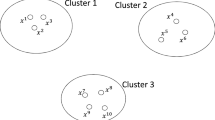Abstract
Two strategies of randomized search, namely adaptive cluster covering (ACCO), and adaptive cluster covering with descent (ACD), are introduced and positioned in the group of the global optimization techniques. Several algorithms based on these new strategies are compared with other techniques of global randomized search in terms of effectiveness, efficiency and reliability. The other techniques include two versions of multistart, two versions of the controlled random search (CRS2 and CRS4) and the canonical genetic algorithm. Thirteen minimization problems including two parameter identification problems (for a flexible membrane mirror model and a hydrologic model) are solved. The algorithm ACCO, and a version of CRS4 algorithm (Ali and Storey 1994) show the highest efficiency, effectiveness and reliability. The second new algorithm, ACD, is in some runs very efficient and effective, but its reliability needs further improvement.
Similar content being viewed by others
References
Ali, M.M. and Storey, C. (1994), Modified controlled random search algorithms, Intern. J. Computer Math. 53:229-235.
Ali, M.M. and Storey, C. (1994), Topographical multilevel single linkage, Journal of Global Optimization 5:349-358.
Archetti, F. and Schoen, F.A. (1984), Survey on the global optimization problem:general theory and computational approaches, in J.C. Baltzer (ed.), Annals of Operations Research 1, pp. 87-110, A.G. Publishing.
Back, T. and Schwefel, H.P. (1993), An overview of evolutionary algorithms for parameter optimization, Evolutionary Computation 1(1):1-23.
Brent, R.P. (1973), Algorithms for Minimization without Derivatives. Prentice-Hall, Englewood-Cliffs, N.J.
Cieniawski, S.E, Eheart, J.W. and Ranjithan, S. (1995), Using genetic algorithms to solve a multiobjective groundwater monitoring problem, Water Resource Research 31(2):399-409.
Dixon, L.C.W. and Szego, G.P., eds. (1978), Towards Global Optimization. North-Holland, Amsterdam.
Duan, Q., Gupta, V. and Sorooshian, S. (1993), Shuffled complex evolution approach for effective and efficient global minimization, J. of Optimization Theory and Applications 76(3):501-521.
Goldberg, D.E. (1989), Genetic Algorithms in Search, Optimization and Machine Learning. Addison-Wesley, Reading, MA.
Gulsen, M., Smith, A.E. and Tate, D.M. (1995), A genetic algorithm approach to curve fitting, Int. J. Prod. Res. 33(7):1911-1923.
Griewank, A.O. (1981), Generalized descent for global optimization, J. of Optimization Theory and Applications 34(1):11-39.
Jacobs, D.A.H. (1977), The State of the Art in Numerical Analysis. Academic Press, London.
Locatelli, M. and Schoen, F. (1996), Simple linkage:ppanalysis of a threshold-accepting global optimization method, Journal of Global Optimization 5:95-111.
Michalewicz, Z. (1992), Genetic Algorithms + Data Structures = Evolution Programs. Springer Verlag, Berlin.
Nelder, J.A. and Mead, R. (1995), A simplex method for function minimization, Computer Journal 7(4):308-313.
Neumaier, A. (1997), WWWpage http://solon.cma.univie.ac.at/ neum/glopt.html Pintér, J.D. (1995), Global Optimization in Action. Kluwer Academic Publishers, Dortrecht/Boston/London.
Powell, M.J.D. (1964), An efficient method of finding the minimum of a function of several variables without calculating derivatives, Computer Journal 7:155-162.
Press, W.H., Flannery, B.P., Teukolsky, S.A. and Vetterling, W.T. (1990), Numerical Recipes in Pascal. The Art of Scientific Computing. Cambridge University Press, Cambridge.
Price W.L. (1983), Global optimization by controlled random search, Journal of Optimization Theory and Applications 40:333-348.
Rinnoy Kan, A.H.G. and Timmer, G.T. (1987), Stochastic global optimization methods. I. Clustering methods, II. Multilevel methods, Mathematical Programming 39(1):27-56 and 57-78.
Rosenbrock, H.H. (1960), An automatic method for finding the greatest or least value of a function, Computer J. 3:175-184.
Schoen, F. (1991), Stochastic techniques for global optimization, Journal of Global Optimization 1: 207-228.
Solomatine, D.P. (1995), The use of global random search methods for models calibration, Proc. 26th Congress of the International Association for Hydraulic Research, Vol. 1, pp. 224-229, London.
Sugawara, M. (1978), Automatic calibration of the tank model, Proc. Intern. Symposium on Logistics and Benefits of Using Mathematical Models of Hydrologic and Water Resource Systems. IIASA, Laxenburg, Austria.
Törn, A. (1978), A search clustering approach to global optimization, in Towards Global Optimization, Vol. 2, pp. 49-62. North-Holland, Amsterdam.
Törn, A. and Žilinskas, A. (1989), Global Optimization. Springer Verlag, Berlin.
Törn, A. and Viitanen, S. (1994), Topographical Global Optimization using pre-sampled points, Journal of Global Optimization 5:267-276.
Törn, A. (1997), WWW page www.abo.fi/ atorn/globopt.html.
Vdovine, G., Middelhoek, S., Bartek, M., Sarro, P.M., and Solomatine, D.P. (1995), Technology, characterization and applications of adaptive mirrors fabricated with IC-compatible micromachining, Proc. SPIE's Intern. Symposium on Optical Science, Engineering and Instrumentation, Conference 'Adaptive Optical Systems and Applications', Vol. 2534/13, San Diego, USA.
Wang, Q.J. (1991), The genetic algorithm and its application to calibrating conceptual rainfall-runoff models, Water Resource Research 27(9):2467-2471.
Zhigljavsky, A. (1991), Theory of Global Random Search. Kluwer Academic Publishers, Dordrecht/ Boston/London.
Author information
Authors and Affiliations
Rights and permissions
About this article
Cite this article
Solomatine, D. Two Strategies of Adaptive Cluster Covering with Descent and Their Comparison to Other Algorithms. Journal of Global Optimization 14, 55–78 (1999). https://doi.org/10.1023/A:1008334632441
Issue Date:
DOI: https://doi.org/10.1023/A:1008334632441




